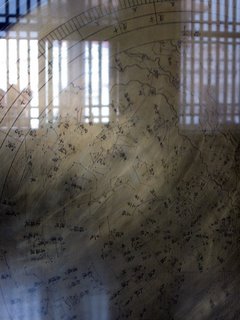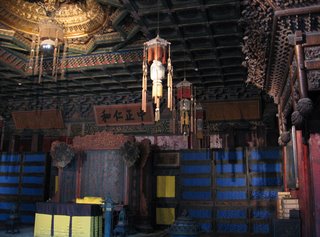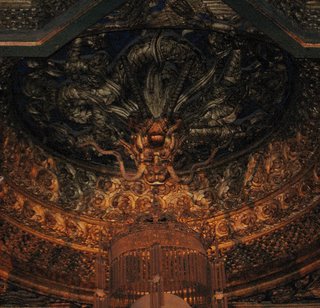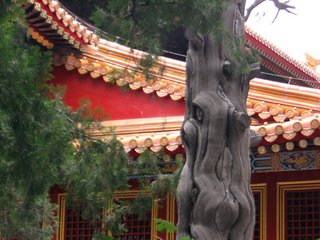 I am somewhat embarrassed to say that I wasn't exactly sure which part of the vast area was the legendary Tiananmen Square. A subsequent search of image results from Google (almost none of which are reachable from behind the Great Firewall of China, incidentally) suggest that it was just the vast area. It seemed to stretch for miles, and made my feet hurt just looking at it. Also, there were groups of green-uniformed soldiers patrolling about. It was a bit odd, I admit, but they didn't seem very fierce. Some of them smiled a bit even. Still, I prudently photographed them when their backs were turned.
I am somewhat embarrassed to say that I wasn't exactly sure which part of the vast area was the legendary Tiananmen Square. A subsequent search of image results from Google (almost none of which are reachable from behind the Great Firewall of China, incidentally) suggest that it was just the vast area. It seemed to stretch for miles, and made my feet hurt just looking at it. Also, there were groups of green-uniformed soldiers patrolling about. It was a bit odd, I admit, but they didn't seem very fierce. Some of them smiled a bit even. Still, I prudently photographed them when their backs were turned.It was a bit of a trick to find the Forbidden City, too, because it's mostly not called the Forbidden City, or on some signs it is and on some signs it is called "The Palace Museum" instead. So I'd find myself getting really close and then somehow getting lost at the last minute. I finally did manage, though. The door price was 60 RMB, an astronomical $7.50. Wow. There's a discount for students and for the elderly, though at present I wasn't either of those. I forked over my 60 RMB, elected to skip the audio or guided tour, and wandered in.
 The first thing I noticed was the famous knobbed doors. The most wonderful thing about these doors, though, was how the gold knobs within reach have been rubbed and tarnished by so very many hands. Indeed, even as I watched, almost everyone who passed by reached out to touch them. I don't know whether there's a special symbolism in it, or whether there's a certain basic appeal in their rounded shape, or whether seeing something that has been so obviously touched by everyone else makes one want to touch it too. Whatever the case, there was a special meaning to it in my mind--the way the masses pour through the gates of the once-forbidden city, and leave their mark on it, claiming it as their right. I will add that some of the knobs had protective plastic walls over them, but this is completely missing the point of the phenomenon, in my opinion.
The first thing I noticed was the famous knobbed doors. The most wonderful thing about these doors, though, was how the gold knobs within reach have been rubbed and tarnished by so very many hands. Indeed, even as I watched, almost everyone who passed by reached out to touch them. I don't know whether there's a special symbolism in it, or whether there's a certain basic appeal in their rounded shape, or whether seeing something that has been so obviously touched by everyone else makes one want to touch it too. Whatever the case, there was a special meaning to it in my mind--the way the masses pour through the gates of the once-forbidden city, and leave their mark on it, claiming it as their right. I will add that some of the knobs had protective plastic walls over them, but this is completely missing the point of the phenomenon, in my opinion.Another thing I especially loved was the way plants were growing everywhere, on every surface they could, and being fought back by overmatched crews of workers.

According to my Lonely Planet Beijing:
The palace is so large (720,000 sq meters, 800 buildings, 9000 rooms) that a permanent restoration squad moves around repainting and repairing it. It's estimated to take about 10 years to do a full renovation, by which time they have to start repairs again.
 I can personally testify that the place was huge. I spent hours there and saw less than half of it before it closed. But here's a photo of one of my favorite subjects: restoration effects. The building behind the screen was so completely taken apart that there was nothing but scaffolding. However, the huge screen was printed with a huge photograph of what was supposed to be there, and was somehow quite impressive.
I can personally testify that the place was huge. I spent hours there and saw less than half of it before it closed. But here's a photo of one of my favorite subjects: restoration effects. The building behind the screen was so completely taken apart that there was nothing but scaffolding. However, the huge screen was printed with a huge photograph of what was supposed to be there, and was somehow quite impressive.Lest you think I spent all my time noticing its flaws, I also enjoyed tremendously the stone bridges and waterways. The day was fairly calm, though overcast, so the water looked a smooth, jade green.


The little side halls of the palace had exhibitions in them. There was no photography allowed in the "Arms and Armor" exhibition, but that was okay because the weapons were creepily deadly looking--especially the arrows.
 I did take some pictures of scientific instruments, however, because I know I have a reader or two who is interested in such things.
I did take some pictures of scientific instruments, however, because I know I have a reader or two who is interested in such things.It wasn't easy to take these pictures, because a flash would have reflected off the glass, but taking them without flash required a very steady hand, and there were bright reflections anyway. Well, make a virtue of necessity, right? I thought this instrument looked interesting in a confusing whirl of light.
 I also took a picture of the surface of a star-map, all in Chinese, with reflections from the window which I thought looked very cool.
I also took a picture of the surface of a star-map, all in Chinese, with reflections from the window which I thought looked very cool.There is no way to even begin to describe the many interesting art objects I saw, and interesting roofs and tiles and sculptures. But one other interesting thing I think I should mention was the emperor's bed-chamber. In refitting the city as a museum, they made the wonderful choice of allowing you to look at all these things through windows, as if you were peeping in on imperial life, so to speak. The pictures below are from the emperor's own bedchamber. The first one is a full view and the other three are details. I'm not sure I would sleep well with that scary big dragon above me. But, as the Bard has so well put it, uneasy lies the head...




Oh, there were so many wonders, both historical and present-day. A little palace building turned into a snack-shop where I bought a bucket of ramen and ate it slowly
 under the trees in an imperial pavilion. A veritable maze of long walks and walls and tiny doors and huge doors and brilliantly colored tiles and decorated roofs, in all states of restoration and disrepair. One of the things I liked best--for if you know me, you know the my-eye view is for the small and detailed and less obviously lovely--were the tiny mosaics on the ground in a certain place. Here are my brown shoes just barely trespassing on one of them. But I took many many more pictures, for there were a really endless number of them, each different, and I am thinking of making a separate post about them.
under the trees in an imperial pavilion. A veritable maze of long walks and walls and tiny doors and huge doors and brilliantly colored tiles and decorated roofs, in all states of restoration and disrepair. One of the things I liked best--for if you know me, you know the my-eye view is for the small and detailed and less obviously lovely--were the tiny mosaics on the ground in a certain place. Here are my brown shoes just barely trespassing on one of them. But I took many many more pictures, for there were a really endless number of them, each different, and I am thinking of making a separate post about them. Another thing I thought very fine were the gnarled old trees, some growing straight and standing under their own power, others bent over and barely held up with patches and supports. This tough, knobbly old creature made a nice picture, I thought.
Another thing I thought very fine were the gnarled old trees, some growing straight and standing under their own power, others bent over and barely held up with patches and supports. This tough, knobbly old creature made a nice picture, I thought.I could go on and on with this, but the best thing would be for you to come see it for yourself. Alternatively, there are lots more photos on my flickr site (e-mail me for the url), though I have not yet figured out how to organize things very well there. Just look for the golden palace roofs and red walls!
To end is one of my favorite pictures of rooftop grass (but this is only one of very many such pictures that I took!), and also one of a blue bowl which is not perfectly in focus but I thought the color was so wonderful.


I left when the place closed at perhaps 5 or so. I had the most exhilarated feeling. In general, I feel conflicted about places of great richness and beauty. Richness, I suppose, being the key. You can't get such places without a cruel stratification of society, so even as I love them I have to hate them too, in a historical sense. But as in Beihai Park, which was once a palace and now a place for everyone, I felt that a very good thing has happened to those magnificent old buildings. We commoners, once forbidden entry on pain of death, slurp away at our noodles under the golden eaves. And for all I have many many qualms about the CCP, this is really a good thing they have brought to China, this one thing--that the worst thing about this place (its cruel forbiddenness) was destroyed, and many of the best things preserved. Maybe that's why I liked so much the signs of disrepair and renewal. No one around to say, "Grass growing on the roof!? Where's that guttersweep? Off with his head!" But neither is the place going to ruin.
I suppose the same praise can be applied to a lot of historic places, but the ubiquity takes nothing away from the praiseworthiness!
 It took me almost two hours to get all the way home in the evening rush. It began to rain while I was on the subway. The bus was so packed that I couldn't even get off at my stop, and only just pushed my way out in time for the next one. That was a happy accident, though, because there I saw a man selling these magnificent spiny fruits. They are some kind of rambutan, I think, and the man who sold them to me cut one open for me to taste. No doubt I paid too much for it, because when he stated the price (a bit less than $3 for this massive bunch) and I agreed and paid it, the next fruit-seller over laughed incredulously and muttered a suggestion. "Buy another? Do!" said the rambutan-seller pushily in response. "I'm only one person," I snapped testily, and took away my purchase. I never saw anyone else bargain with fruit-sellers. Anyway, I was pleased with my purchase, whatever its cost. I'd be lucky to get even one rambutan for $3 in the states, if I found one at all.
It took me almost two hours to get all the way home in the evening rush. It began to rain while I was on the subway. The bus was so packed that I couldn't even get off at my stop, and only just pushed my way out in time for the next one. That was a happy accident, though, because there I saw a man selling these magnificent spiny fruits. They are some kind of rambutan, I think, and the man who sold them to me cut one open for me to taste. No doubt I paid too much for it, because when he stated the price (a bit less than $3 for this massive bunch) and I agreed and paid it, the next fruit-seller over laughed incredulously and muttered a suggestion. "Buy another? Do!" said the rambutan-seller pushily in response. "I'm only one person," I snapped testily, and took away my purchase. I never saw anyone else bargain with fruit-sellers. Anyway, I was pleased with my purchase, whatever its cost. I'd be lucky to get even one rambutan for $3 in the states, if I found one at all.As I walked home in the rain--of course I had forgotten my umbrella--it was growing dark. The pretty restaurant girls in their fakish traditional garb were all wearing yellow raincoats over their finery, which made me laugh. I made a point of never going to a restaurant that has a pretty girl in pretentious qipao or hanbok. It just seems gimmicky and a sure-fire sign that the place will be overpriced.
I was pleased and very very tired. I had had an early morning taking a Chinese placement taste (mainly not too difficult, though I did not get everything right, I am quite certain). I was also a little regretful, because on my way out to the Forbidden City, I had suddenly caught sight of the goldfish seller, selling goggle-eyed goldfish on the street! How wonderful they were, and how my water-filled fishbowl longed for one, maybe a nice black one that wouldn't clash with the weird red sofa! But everything has its opportunity cost, and the Forbidden City had certainly been a memorable experience.
Would you believe it, after all this excitement and walking, I still had to go out again that evening? I had gotten a call regarding the International Student Communication Association--the ones who were to provide free tutors and all? They were having a welcoming meeting at 9:15 PM in the international students' cafeteria. After nine PM! Why on most nights I'm peacefully asleep by then! But I did grumblingly drag my aching feet back out the door. It was a very stormy night, with thunder and lightning. I was impressed in spite of myself by the drama of it.
The ISCA meeting was dramatic too--dramatically chaotic. I have noticed a certain penchant, in Chinese people's interactions with poor confused Westerners, to plan activities which are tremendously complex, and at the same time provide little or no explanation of what we are supposed to do. This one involved sitting in designated areas only, but it wasn't clear which areas these were, and then having timed amounts of "communication." "We will also have some ice-breaking games so you will get to know each other," the girl at the microphone announced to the sound of silent groans of dismay from the international students in the audience. Ice-breaking games are so uncool. This one actually turned out to be fun, involving a clapping pattern, and various permutations of the sentence "Guangdong fried noodles are spicy, spicy, spicy!" However, you had to have a powerfully positive frame of mind to be willing to give it a try, after such an uninspiring introduction. (Fortunately I do.) I met a math major and a few international studies majors, and they were terribly young (and I offended one of them by asking her name twice--people hate that), but I think it will be fun to go out with them once in a while. At least they're Chinese students, and so will know things about the place that I don't.
One of them asked me to give him an English name. As I barely knew him, I decided to choose one that sounded something like his Chinese name, which was Chen Chang. So I decided on "Charles." Here's to you, Chaz, you have a Chinese namesake now. It was actually kind of fun giving someone a name. I felt honored.
I was very tired by the time I made my slow way back home. The big streets seemed even bigger. There weren't many people about on a stormy Thursday night, though the cars raced about as aggressively as ever. Still, it had been quite a satisfying day, a day that made me feel I was really in a new and fascinating place rather than a lazy stay-at-home who could be anywhere!

No comments:
Post a Comment